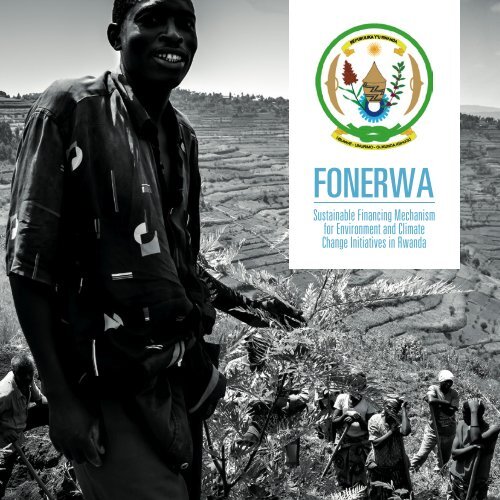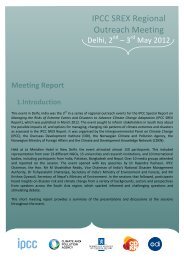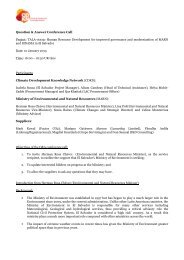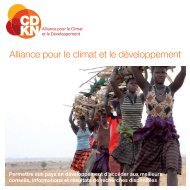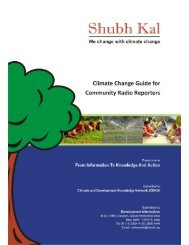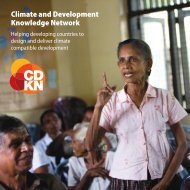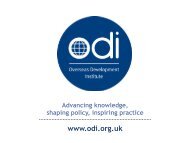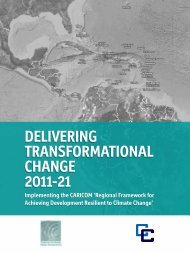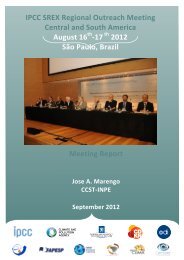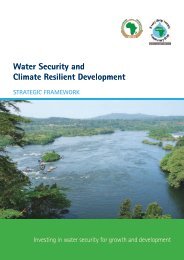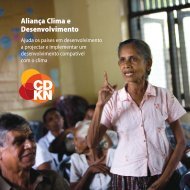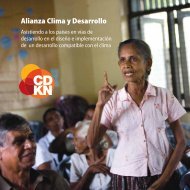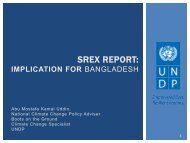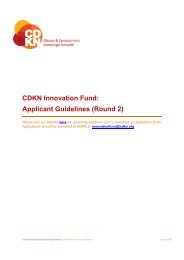What is FONERWA and how will it work?
What is FONERWA and how will it work?
What is FONERWA and how will it work?
Create successful ePaper yourself
Turn your PDF publications into a flip-book with our unique Google optimized e-Paper software.
<strong>What</strong> <strong>is</strong><br />
<strong>FONERWA</strong>?<br />
The Government of Rw<strong>and</strong>a (GoR) <strong>is</strong> in the process of final<strong>is</strong>ing the<br />
establ<strong>is</strong>hment of the Environment <strong>and</strong> Climate Change Fund – <strong>FONERWA</strong> –<br />
as a cross sectoral financing mechan<strong>is</strong>m to achieve development objectives<br />
of environmentally sustainable, climate resilient <strong>and</strong> green economic<br />
growth. The establ<strong>is</strong>hment of <strong>FONERWA</strong> demonstrates Rw<strong>and</strong>a’s continued<br />
comm<strong>it</strong>ment to sustainable development <strong>and</strong> a green economy.<br />
<strong>FONERWA</strong> 1 <strong>is</strong> the vehicle in Rw<strong>and</strong>a through which environment <strong>and</strong> climate<br />
change finance <strong>is</strong> channelled, programmed, d<strong>is</strong>bursed <strong>and</strong> mon<strong>it</strong>ored. As a<br />
national Basket Fund, <strong>FONERWA</strong> <strong>is</strong> an instrument to facil<strong>it</strong>ate direct access<br />
to international environment <strong>and</strong> climate finance, as well as to streamline<br />
<strong>and</strong> rational<strong>is</strong>e external aid <strong>and</strong> domestic finance. Access to the Fund <strong>is</strong><br />
open to line min<strong>is</strong>tries <strong>and</strong> d<strong>is</strong>tricts, char<strong>it</strong>able <strong>and</strong> private ent<strong>it</strong>ies, including<br />
businesses, civil society <strong>and</strong> research inst<strong>it</strong>utions.<br />
1 The French acronym, <strong>FONERWA</strong>, was coined in 2005 under Organic Law no.4/2005 <strong>and</strong> means fund<br />
for environment <strong>and</strong> natural resources for Rw<strong>and</strong>a. Through the <strong>FONERWA</strong> Law, <strong>it</strong> has taken on the<br />
add<strong>it</strong>ional meaning of environment <strong>and</strong> climate change fund for Rw<strong>and</strong>a.
Objectives of<br />
<strong>FONERWA</strong>?<br />
Results Pillar 1<br />
Conservation & management<br />
of natural resources<br />
strengthened <strong>and</strong> sustained.<br />
Results Pillar 2<br />
R&D <strong>and</strong> technology<br />
transfer <strong>and</strong> implementation<br />
facil<strong>it</strong>ated <strong>and</strong> util<strong>is</strong>ed.<br />
Results Pillar 3<br />
Environment <strong>and</strong> climate<br />
change <strong>is</strong>sues mainstreamed<br />
into policies, programmes,<br />
plans, budgets <strong>and</strong><br />
activ<strong>it</strong>ies for public <strong>and</strong><br />
non-public agencies.<br />
<strong>FONERWA</strong> design <strong>is</strong> based on three considerations: 1) Alignment w<strong>it</strong>h the<br />
<strong>FONERWA</strong> Law, 2) Reflection of <strong>FONERWA</strong>’s national character <strong>and</strong> identified<br />
national prior<strong>it</strong>ies for environment, climate & development <strong>and</strong> 3) Meeting<br />
demonstrated financing needs for environment <strong>and</strong> climate change projects<br />
<strong>and</strong> programmes that demonstrate high value for money.<br />
Grounded in Managing for Results principles, these considerations are<br />
reflected in <strong>FONERWA</strong>’s key objectives:<br />
Overall objective<br />
<strong>FONERWA</strong> has the overarching objective of contributing to sustainable wealth<br />
creation <strong>and</strong> poverty reduction in Rw<strong>and</strong>a, through sustainable management<br />
of natural resources, climate resilient <strong>and</strong> green economic growth 2 .<br />
Outcome<br />
The outcome of the <strong>FONERWA</strong> Fund <strong>is</strong> to sustainably <strong>and</strong> equ<strong>it</strong>ably finance<br />
<strong>and</strong> further strengthen national programmes <strong>and</strong> private sector in<strong>it</strong>iatives<br />
in the areas of current <strong>and</strong> future environment <strong>and</strong> climate change, <strong>and</strong><br />
development related challenges <strong>and</strong> opportun<strong>it</strong>ies.<br />
Results<br />
In order to achieve the above, <strong>FONERWA</strong> <strong>will</strong> deliver the following results.<br />
2 Green economic growth implies economic growth <strong>and</strong> development w<strong>it</strong>h lim<strong>it</strong>ed negative environment<br />
<strong>and</strong> climate-related external<strong>it</strong>ies.
Scope of<br />
<strong>FONERWA</strong><br />
design?<br />
The <strong>FONERWA</strong> design frame<strong>work</strong> cons<strong>is</strong>ts of four Thematic Financing<br />
Windows <strong>and</strong> respective entry points, or prior<strong>it</strong>y investment areas. Thematic<br />
Financing Windows structure <strong>and</strong> categor<strong>is</strong>e the prior<strong>it</strong>ies of the GoR in<br />
relation to environment <strong>and</strong> climate objectives, as reflected in various GoR<br />
policies, strategies <strong>and</strong> relevant studies that demonstrate financial need.<br />
In support of these prior<strong>it</strong>ies, <strong>FONERWA</strong> <strong>is</strong> expected to make a significant<br />
contribution (20-30%) to Rw<strong>and</strong>a’s ex<strong>is</strong>ting financing gap, estimated at<br />
approximately US $100 million per year across the Thematic Financing<br />
Windows. Mobil<strong>is</strong>ation of resources on th<strong>is</strong> scale <strong>will</strong> require significant<br />
contributions from Rw<strong>and</strong>a’s development partners, ex<strong>is</strong>ting <strong>and</strong> emerging<br />
international funds (e.g. the Green Climate Fund) <strong>and</strong> the private sector,<br />
among other sources, as the Fund matures.<br />
Thematic windows <strong>and</strong> entry points are expected to evolve over time based<br />
on dem<strong>and</strong>s <strong>and</strong> future aspirations of the GoR <strong>and</strong> other beneficiaries. As a<br />
result, further prior<strong>it</strong><strong>is</strong>ation <strong>and</strong> resource allocation dec<strong>is</strong>ions across windows<br />
<strong>will</strong> be based on emerging prior<strong>it</strong>ies, the nature of investments from various<br />
sources <strong>and</strong> importantly value for money considerations. Transformational<br />
projects <strong>and</strong> programmes that demonstrate maximum economies of scale,<br />
efficiency <strong>and</strong> effectiveness <strong>will</strong> be given highest prior<strong>it</strong>y.
Thematic financing<br />
windows <strong>and</strong> entry points<br />
for Fund cap<strong>it</strong>al<strong>is</strong>ation<br />
<strong>and</strong> expend<strong>it</strong>ure.<br />
Window 1<br />
Conservation & Sustainable Natural<br />
Resources Management<br />
Window 2<br />
R&D & Technology Transfer<br />
& Implementation<br />
1. Ecosystem rehabil<strong>it</strong>ation 1. Renewable energy & energy efficiency technology<br />
2. Sustainable l<strong>and</strong> management 2. Pollution management<br />
3. Integrated water resource management (IWRM) 3. Water storage, conservation <strong>and</strong><br />
irrigation technologies<br />
4. Sustainable forestry management 4. Applied <strong>and</strong> adaptive research<br />
(agroforestry, waste, urban planning)<br />
5. Sustainable mines & quarries 5. D<strong>is</strong>aster r<strong>is</strong>k reduction<br />
6. Promotion & protection of biodivers<strong>it</strong>y 6. Data collection, mon<strong>it</strong>oring &Management<br />
Information System (MIS)
Windows 3<br />
Environment & Climate<br />
Change Mainstreaming<br />
Window 4<br />
Environmental Impact Assessment<br />
(EIA) Mon<strong>it</strong>oring & Enforcement<br />
1. Strategic Environment & Climate<br />
Assessments (SECAs)<br />
1. Mon<strong>it</strong>oring implementation of environment<br />
management plans for cap<strong>it</strong>al projects<br />
2. Sector-specific adaptation <strong>and</strong> m<strong>it</strong>igation 2. Environmental aud<strong>it</strong>ing<br />
3. Support to implementation of<br />
cross‐sectoral integrated planning
How <strong>will</strong><br />
<strong>FONERWA</strong> be<br />
cap<strong>it</strong>al<strong>is</strong>ed?<br />
<strong>FONERWA</strong> allows for contributions from both internal <strong>and</strong> external sources,<br />
including contributions from the private sector.<br />
Domestic cap<strong>it</strong>al<strong>is</strong>ation sources include: (1) Environmental fines <strong>and</strong> fees,<br />
(2) EIA fees (mentioned above), (3) Proceeds from Forestry <strong>and</strong> Water Funds,<br />
(4) Other environmental revenue <strong>and</strong> (5) Seed financing from domestic<br />
stakeholders (line min<strong>is</strong>tries). In fact, <strong>FONERWA</strong> <strong>is</strong> the only fund in Rw<strong>and</strong>a<br />
that mobil<strong>is</strong>es resources from the GoR’s own revenue sources, making <strong>it</strong> less<br />
vulnerable to external aid shocks.<br />
External cap<strong>it</strong>al<strong>is</strong>ation sources include bilateral <strong>and</strong> multilateral development<br />
partners’ contributions <strong>and</strong> access to international environment <strong>and</strong> climate<br />
funds.<br />
Private sector contributions <strong>will</strong> be considered in the form of grants <strong>and</strong><br />
project co-financing in the short-term (0-1 years), <strong>and</strong> investment (e.g. equ<strong>it</strong>y)<br />
in the long-term (>5 years), among others.
<strong>What</strong> financial<br />
instruments<br />
<strong>will</strong> <strong>FONERWA</strong><br />
offer?<br />
<strong>FONERWA</strong> <strong>will</strong> util<strong>is</strong>e several instruments to achieve <strong>it</strong>s objectives, phasing in<br />
more complicated instruments over time, depending on actual <strong>and</strong> emerging<br />
needs. Figure 1 on the following page presents the financing instruments in<br />
the short term (ST), medium term (MT), <strong>and</strong> long term (LT), <strong>and</strong> targeted<br />
beneficiaries, which includes national (line min<strong>is</strong>tries) <strong>and</strong> sub-national (e.g.<br />
D<strong>is</strong>tricts) Government bodies, civil society <strong>and</strong> the private sector.<br />
In the short-term (0-1 years), two primary financial instruments are proposed<br />
for both public <strong>and</strong> private beneficiaries: (1) In-kind support for proposal<br />
development <strong>and</strong> (2) Performance-based grants, a component of which <strong>will</strong><br />
be co-financing (e.g. for private sector beneficiaries). In-kind support includes<br />
mostly technical ass<strong>is</strong>tance for proposal development to project promoters<br />
<strong>and</strong>, in some cases, offset of proposal development costs through grants.<br />
For the first two years, the major<strong>it</strong>y of resource allocations to the private<br />
sector (20% of total fund resources) <strong>will</strong> come in the form of grants until<br />
guarantee <strong>and</strong> concessional loan facil<strong>it</strong>ies are introduced. Medium-term (2-5<br />
years) instruments <strong>will</strong> include more complicated financial instruments,<br />
namely low interest <strong>and</strong>/or concessional loans.<br />
Long-term (>5 years) financial instruments such as equ<strong>it</strong>y investments<br />
are expected to be introduced several years into the operational<strong>is</strong>ation of<br />
<strong>FONERWA</strong>, subject to the Fund’s performance <strong>and</strong> private sector dem<strong>and</strong>. The<br />
makeup <strong>and</strong> sequencing of these phased developments <strong>will</strong> be determined<br />
by the evolution of the Fund <strong>and</strong> the <strong>FONERWA</strong> Managing Comm<strong>it</strong>tee.
Figure 1<br />
Proposed financial<br />
<strong>and</strong> non-financial<br />
instruments for <strong>FONERWA</strong>
<strong>What</strong> <strong>is</strong> <strong>FONERWA</strong>’s<br />
governance<br />
structure?<br />
The governance structure of <strong>FONERWA</strong> allows the GoR, development<br />
partners, Private Sector <strong>and</strong> civil society oversight of projects/ programmes to<br />
ensure maximum transparency <strong>and</strong> accountabil<strong>it</strong>y. Figure 2 on the following<br />
page illustrates the <strong>FONERWA</strong> governance structure cons<strong>is</strong>ting of a Managing<br />
Comm<strong>it</strong>tee, Technical Comm<strong>it</strong>tee <strong>and</strong> Secretariat.<br />
The Min<strong>is</strong>try of Environment <strong>and</strong> Natural Resources (MINIRENA) of the GoR<br />
<strong>is</strong> the national inst<strong>it</strong>ution responsible for Fund oversight. Under MINRENA<br />
guidance, the Rw<strong>and</strong>a Environment Management Author<strong>it</strong>y (REMA) <strong>will</strong><br />
house the <strong>FONERWA</strong> Secretariat, w<strong>it</strong>h the support of a Fund Management<br />
Team, recru<strong>it</strong>ed by Department of International Development (DfID) of the<br />
UK Government for an in<strong>it</strong>ial two year period.<br />
The <strong>FONERWA</strong> Managing Comm<strong>it</strong>tee <strong>will</strong> be responsible for mon<strong>it</strong>oring <strong>and</strong><br />
directing the Fund’s activ<strong>it</strong>ies. It <strong>is</strong> the highest organ in the Government of<br />
Rw<strong>and</strong>a for <strong>FONERWA</strong> management <strong>and</strong> oversight, <strong>and</strong> involves participation<br />
from stakeholders including the GoR at central (Permanent Secretaries)<br />
<strong>and</strong> d<strong>is</strong>trict levels (through the Min<strong>is</strong>try of Local Government, MINALOC),<br />
development partners, civil society, <strong>and</strong> the private sector.<br />
The <strong>FONERWA</strong> Technical Comm<strong>it</strong>tee <strong>will</strong> be responsible for ensuring<br />
strong ownership of <strong>FONERWA</strong>-supported activ<strong>it</strong>ies, <strong>and</strong> enhancing their<br />
sustainabil<strong>it</strong>y. The Technical Comm<strong>it</strong>tee <strong>will</strong> cons<strong>is</strong>t of Director Generals from<br />
key environment <strong>and</strong> climate related sectors, as well as development partners.<br />
The <strong>FONERWA</strong> Secretariat <strong>will</strong> provide facil<strong>it</strong>ation for the central coordination<br />
of the Fund, w<strong>it</strong>h the support of a Fund Management Team in the first two<br />
years of operation.
Figure 2<br />
<strong>FONERWA</strong><br />
governance<br />
structure
Who can<br />
access<br />
<strong>FONERWA</strong>?<br />
The fund can be accessed by line min<strong>is</strong>tries, Government agencies, D<strong>is</strong>tricts,<br />
Civil Society Organ<strong>is</strong>ations (CSOs) including academic inst<strong>it</strong>utions <strong>and</strong> the<br />
private sector, as long as the proposed activ<strong>it</strong>ies are in compliance w<strong>it</strong>h Fund<br />
eligibil<strong>it</strong>y cr<strong>it</strong>eria, <strong>and</strong> the project/programmes are screened through various<br />
steps as d<strong>is</strong>cussed in the project screening section of th<strong>is</strong> document. At least<br />
20% of total <strong>FONERWA</strong> resources <strong>will</strong> be earmarked for the private sector for<br />
use across Thematic Financing Windows, <strong>and</strong> at least 10% of Fund resources<br />
<strong>will</strong> be earmarked for D<strong>is</strong>tricts.
How <strong>will</strong><br />
the <strong>FONERWA</strong><br />
application<br />
process <strong>work</strong>?<br />
The <strong>FONERWA</strong> project/programme proposal screening <strong>will</strong> be carried out in<br />
a fair <strong>and</strong> transparent, multi-step process. Th<strong>is</strong> <strong>will</strong> be overseen by the Fund<br />
Management Team/Secretariat <strong>and</strong> Technical Comm<strong>it</strong>tee, w<strong>it</strong>h ultimate<br />
funding dec<strong>is</strong>ions made by the Managing Comm<strong>it</strong>tee.<br />
Figure 3, <strong>and</strong> <strong>it</strong>s corresponding descriptions on the following page, details the<br />
6 key steps of the proposed screening process.
6 key steps<br />
of the proposed screening process<br />
Step 1 Subm<strong>is</strong>sion of Project<br />
Profile Document (PPD)<br />
Line Min<strong>is</strong>tries/private sector/civil society should<br />
complete Project Profile Documents (PPDs) for proposals<br />
to be considered by the <strong>FONERWA</strong> Secretariat, in<br />
conform<strong>it</strong>y w<strong>it</strong>h <strong>FONERWA</strong> Thematic Financing<br />
Windows key entry points.<br />
Step 2 Review for Eligibil<strong>it</strong>y Cr<strong>it</strong>eria<br />
PPDs <strong>will</strong> be screened by the Fund Management Team<br />
against eligibil<strong>it</strong>y cr<strong>it</strong>eria.<br />
PPD Eligibil<strong>it</strong>y Cr<strong>it</strong>eria<br />
> > Results based, aligns w<strong>it</strong>h thematic windows/<br />
entry points <strong>and</strong> <strong>FONERWA</strong> M&E frame<strong>work</strong><br />
> > Benef<strong>it</strong>s sustained beyond lifetime<br />
of project activ<strong>it</strong>ies<br />
> > Demonstrates value for money<br />
> > Involves ongoing stakeholder consultation<br />
> > Promotes strategic national/international<br />
environment/climate objectives<br />
> > Conforms w<strong>it</strong>h ex<strong>is</strong>ting leg<strong>is</strong>lation,<br />
<strong>and</strong> anti-corruption prov<strong>is</strong>ions<br />
Step 3 Preparation <strong>and</strong> Subm<strong>is</strong>sion<br />
of Full Project Document (PD)<br />
If successful, applicants <strong>will</strong> be asked to subm<strong>it</strong> a full<br />
project document, <strong>and</strong> advice <strong>and</strong> support from the<br />
Fund Management Team to elaborate or improve the<br />
proposal <strong>will</strong> be provided as needed – in particular for<br />
applications targeting other international <strong>and</strong> regional<br />
climate change <strong>and</strong> environment funds.<br />
Step 4 Technical Appra<strong>is</strong>al<br />
<strong>and</strong> Short-l<strong>is</strong>ting of PDs<br />
Full proposals <strong>will</strong> undergo a technical appra<strong>is</strong>al by the<br />
Fund Management Team. The team <strong>will</strong> assess each<br />
PD according to four overall technical appra<strong>is</strong>al cr<strong>it</strong>eria,<br />
each w<strong>it</strong>h detailed sub-cr<strong>it</strong>eria, <strong>and</strong> assign a prior<strong>it</strong>y<br />
ranking for subm<strong>is</strong>sion to the <strong>FONERWA</strong> Technical<br />
Comm<strong>it</strong>tee.<br />
Technical Appra<strong>is</strong>al Cr<strong>it</strong>eria<br />
> > Desirabil<strong>it</strong>y<br />
> > Viabil<strong>it</strong>y<br />
> > Feasibil<strong>it</strong>y<br />
> > Capac<strong>it</strong>y to leverage add<strong>it</strong>ional resources<br />
Step 5 Appra<strong>is</strong>al Review<br />
Following proposal approval at the Technical Appra<strong>is</strong>al<br />
step, the <strong>FONERWA</strong> Technical Comm<strong>it</strong>tee <strong>will</strong> review<br />
the appra<strong>is</strong>al process <strong>and</strong> ensure that <strong>it</strong> was conducted<br />
following establ<strong>is</strong>hed procedures. Suggested project<br />
rankings <strong>will</strong> be further d<strong>is</strong>cussed at th<strong>is</strong> stage before<br />
their subm<strong>is</strong>sion to the <strong>FONERWA</strong> Managing Comm<strong>it</strong>tee.<br />
Step 6 Dec<strong>is</strong>ion Making<br />
The <strong>FONERWA</strong> Management Comm<strong>it</strong>tee <strong>will</strong> be solely<br />
responsible for approval of final funding dec<strong>is</strong>ions.
Figure 3<br />
<strong>FONERWA</strong> Proposal Screening Process
When <strong>will</strong><br />
<strong>FONERWA</strong> be<br />
operational<strong>is</strong>ed?<br />
<strong>FONERWA</strong> <strong>will</strong> begin in<strong>it</strong>ial operations in August 2012. The first round of<br />
proposal subm<strong>is</strong>sions <strong>will</strong> be accepted from January, 2013.
Where can<br />
I find more<br />
information?<br />
As part of the <strong>FONERWA</strong> design process, the following documents have been<br />
prepared <strong>and</strong> are available at www.rema.gov.rw:<br />
Key Design Documents<br />
> > Final report w<strong>it</strong>h rationale for the design features<br />
> > Operational Manual<br />
> > Project Screening Procedure<br />
> > Logical Frame<strong>work</strong><br />
> > Mon<strong>it</strong>oring <strong>and</strong> Evaluation Procedure<br />
> > Procurement <strong>and</strong> Financial Management Procedures<br />
> > Governance Structure Terms of References<br />
> > Capac<strong>it</strong>y Building Plan<br />
*For further information or comments, please contact Dr. Rose Mukankomeje,<br />
Director General of the Rw<strong>and</strong>a Environment Management Author<strong>it</strong>y (REMA)<br />
dgrema@rema.gov.rw
Photo Cred<strong>it</strong>: Jillian Dyszynski <strong>and</strong> Rika Fontana<br />
D<strong>is</strong>claimer: Th<strong>is</strong> document <strong>is</strong> an output from a project funded by the UK<br />
Department for International Development (DFID) for the benef<strong>it</strong> of developing<br />
countries. However, the views expressed <strong>and</strong> information contained in <strong>it</strong> are<br />
not necessarily those of or endorsed by DFID or the members of the Climate<br />
<strong>and</strong> Development Knowledge Net<strong>work</strong>*, which can accept no responsibil<strong>it</strong>y<br />
or liabil<strong>it</strong>y for such views, completeness or accuracy of the information or for<br />
any reliance placed on them<br />
*The Climate <strong>and</strong> Development Knowledge Net<strong>work</strong> (“CDKN”) <strong>is</strong> funded by<br />
the Department for International Development <strong>and</strong> the Dutch Min<strong>is</strong>try of<br />
Foreign Affairs <strong>and</strong> <strong>is</strong> led <strong>and</strong> admin<strong>is</strong>tered by PricewaterhouseCoopers LLP.<br />
PricewaterhouseCoopers LLP <strong>is</strong> ass<strong>is</strong>ted in the management of CDKN by an<br />
alliance of organ<strong>is</strong>ations compr<strong>is</strong>ing the Overseas Development Inst<strong>it</strong>ute,<br />
Fundacion Futuro Latinoamericano, SouthSouthNorth, LEAD International,<br />
<strong>and</strong> INTRAC.<br />
The <strong>FONERWA</strong> Fund has been designed by a team<br />
of consultants from the Centre for International<br />
Development <strong>and</strong> Training (CIDT) (www.wlv.ac.uk/cidt)<br />
of the Univers<strong>it</strong>y of Wolverhampton, UK


